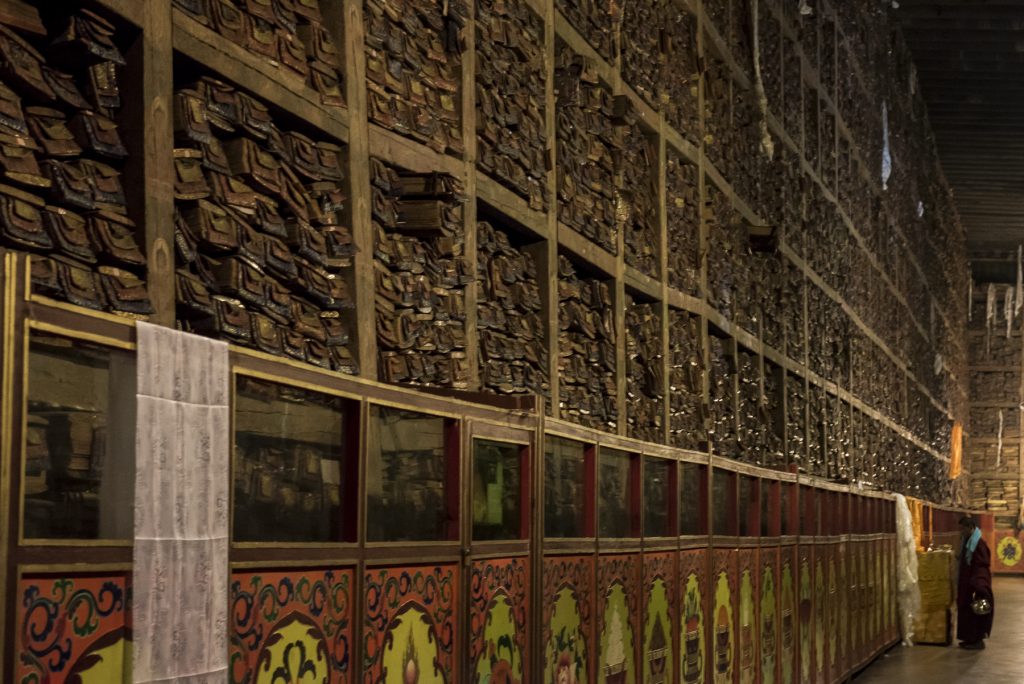Secret Library Found Under a Medieval Monastery Contains Lost Knowledge

Hidden Libraries That Shaped History: A Journey Through Lost Knowledge
The Secret Library of Sakya Monastery
Hidden within the walls of the ancient Sakya Monastery in Tibet, a concealed library containing 84,000 manuscripts was recently unearthed. These manuscripts, safeguarded for over a millennium, cover diverse topics ranging from Buddhist philosophy to ancient technologies. Their discovery offers a rare glimpse into forgotten wisdom and suggests alternative histories of human civilization. Preserved behind a massive 60-meter-long wall, the library symbolizes both the spiritual significance and the cultural richness of Tibetan Buddhism. While its concealment remains a mystery, it is speculated that it was to protect the knowledge from invaders or to preserve its sanctity. This treasure trove continues to reshape our understanding of Tibet’s history and humanity’s shared heritage.
The Hidden Manuscripts of St. Catherine’s Monastery
Tucked beneath Mount Sinai, St. Catherine’s Monastery houses one of the world’s oldest libraries. Among its treasures are palimpsests—manuscripts overwritten with new texts. Modern imaging technologies have revealed hidden layers of ancient writings, including lost Greek poems and early Christian texts in extinct languages like Caucasian Albanian. These findings illuminate the spiritual, artistic, and linguistic diversity of bygone eras. Despite regional conflicts threatening the area, efforts to digitize and share these manuscripts ensure that the hidden knowledge will be accessible to future generations.

The Library of Alexandria: A Symbol of Lost Knowledge
Once the ancient world’s most renowned library, the Library of Alexandria aimed to collect all knowledge of its time. Established during Egypt’s Ptolemaic dynasty, its collection grew through bold initiatives, including copying texts from ships arriving at Alexandria’s harbor. Though its destruction remains shrouded in mystery, it serves as an enduring symbol of humanity’s thirst for knowledge and the fragility of cultural heritage.
The Library of Pergamon
Located in ancient Turkey, the Library of Pergamon was a rival to Alexandria, boasting 200,000 scrolls primarily written on parchment—a material perfected in the city. Pergamon’s rulers fostered a culture of intellectual pursuit, attracting scholars and amassing an impressive collection of texts. Though the library faded due to Roman conquest and natural disasters, its legacy as a center of learning endures.
The Maya Codices: Windows into a Lost Civilization
The Maya codices are ancient books written in hieroglyphics on durable bark paper. Despite the Spanish conquest resulting in the destruction of most codices, a few survive, offering invaluable insights into Maya astronomy, rituals, and beliefs. The Dresden Codex, for instance, reveals the Maya’s sophisticated understanding of planetary movements. These surviving works serve as rare connections to a rich and advanced civilization.
The Royal Library of Ashurbanipal
Established by the Assyrian king Ashurbanipal, this ancient library in modern-day Iraq contained over 30,000 clay tablets, including the famous Epic of Gilgamesh. The library’s destruction during Nineveh’s fall in 612 BCE ironically helped preserve its contents, as the fire baked the clay tablets. Today, these artifacts, housed in the British Museum, provide a window into Mesopotamian religion, medicine, and history.
The House of Wisdom in Baghdad
During the Islamic Golden Age, Baghdad’s House of Wisdom was a beacon of intellectual exchange. Scholars from diverse fields gathered to study, translate, and expand upon knowledge from ancient Greece, Persia, India, and beyond. Its tragic destruction in the 13th century by Mongol invaders marked the loss of countless works, yet its legacy as a hub of scientific and philosophical progress lives on.
The House of Wisdom played a pivotal role in the Great Translation Movement, where scholars translated texts from Greek, Syriac, Persian, and Sanskrit into Arabic. This monumental effort made knowledge from diverse cultures accessible to the Islamic world, laying the groundwork for scientific advancements in the centuries that followed. While not the sole center for translation, the House of Wisdom was among the most renowned, hosting a wealth of manuscripts and serving as a hub for scholars in Baghdad, a bustling multicultural capital. The city’s strategic location drew intellectuals from across the empire, with figures like Al-Kindi and Al-Jahiz contributing to fields such as medicine and astronomy. Its library housed rare books, poetry, and scientific texts, solidifying its reputation as a storehouse of wisdom.
However, the House of Wisdom met a tragic end in 1258 when the Mongols besieged Baghdad, destroying the building and its priceless manuscripts. Although some knowledge survived through copies, the loss was immeasurable. Despite its destruction, the House of Wisdom remains a symbol of how cultures can unite to create extraordinary achievements—a testament to a golden era of intellectual pursuit that sought the betterment of society through shared knowledge.
Similarly, the Imperial Library of Constantinople offers a glimpse into a grand and mysterious past. Protected by the formidable Theodosian Walls, constructed between 408 and 450 CE, the city stood resilient against countless sieges. Within its defenses lay the Imperial Library, established by Emperor Constantius II around 357 CE. This repository safeguarded Greek and Roman works for nearly a millennium, serving as a lifeline for ancient knowledge. The library’s collection, which peaked at approximately 100,000 volumes, included priceless scrolls and manuscripts that scholars meticulously preserved. Unfortunately, fires, wars, and the Fourth Crusade in 1204 severely damaged the library, and much of its collection was lost by the time Constantinople fell to the Ottomans in 1453. Despite this, the library’s legacy endures, as many classical texts that shape modern education owe their survival to its efforts.
In India, Nalanda University, founded in the 4th century CE, was another beacon of knowledge long before Oxford was established. Located in the kingdom of Magadha (modern-day Bihar), this ancient institution featured monasteries, lecture halls, temples, and a legendary library called Dharmaganja, or the “Mountain of Truth.” Divided into three sections—Ratnasagara (“Ocean of Jewels”), Ratnadadhi (“Sea of Jewels”), and Ratnaranjaka (“Delight of Jewels”)—the library housed over 9 million manuscripts, including Upanishads and Sanskrit classics. Scholars traveled from China, Tibet, Korea, and beyond to study subjects ranging from medicine to law. However, the library faced devastating attacks, the most brutal of which occurred in 1193 CE when Turkish invader Bakhtiyar Khilji burned it down, destroying manuscripts over three months and marking the end of Nalanda’s flourishing intellectual era.
In Sri Lanka, the Jaffna Public Library holds deep emotional significance for the Tamil community. Established in 1933, it became one of Asia’s largest libraries, preserving over 97,000 books and manuscripts, including Tamil literature and historical records. It was a symbol of cultural pride and identity. Tragically, in 1981, a mob set the library ablaze, destroying priceless texts and fueling tensions that contributed to the Tamil Tiger insurgency. While the library was rebuilt in 2001, its original collection was irreplaceable. Today, the library stands as a symbol of resilience, its architecture restored to its former glory, and continues to inspire visitors as a testament to cultural endurance.
Whether it’s the House of Wisdom, the Imperial Library of Constantinople, Nalanda University, or the Jaffna Public Library, each represents humanity’s quest for knowledge and the fragility of intellectual treasures. These institutions remind us of the need to cherish and protect the repositories of wisdom that shape our understanding of the world. Hidden libraries and their ancient manuscripts serve as a window into our collective past, offering lessons that continue to resonate in the present.








